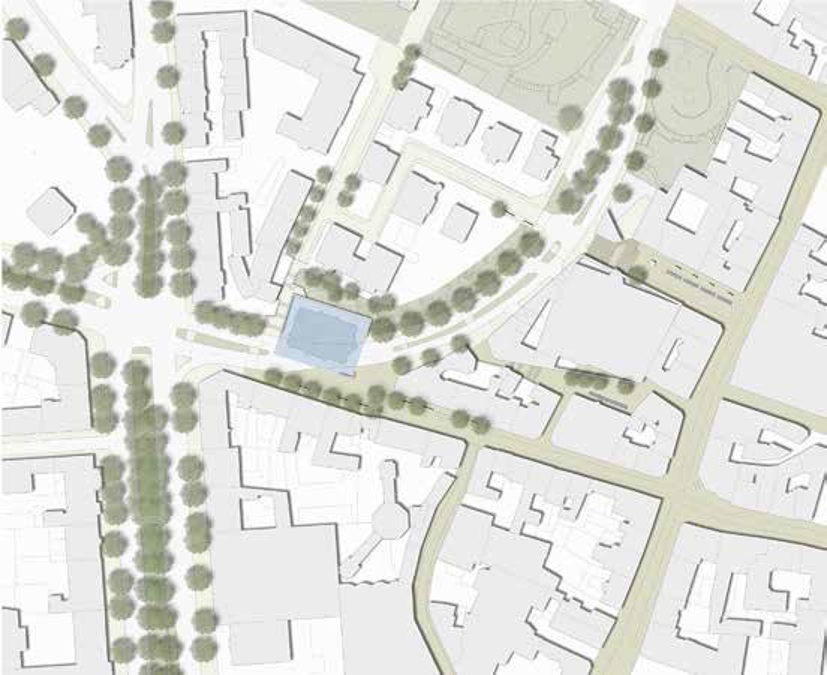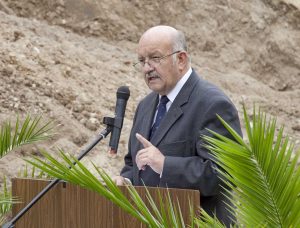(Photographer: [FranzXaver] Süß)
The memorial we designed does not claim to interpret history in a certain way. It invites us to seek a personal interpretation as well as to find a contemporary form for collective remembrance. The design approach is to create a place in the city that provides an opportunity for present as well as future generations to face the process of coming to terms with the Holocaust.
Remembrance in the urban landscape
A cityscape is always the precise reflection of its history, the image of social decisions and historical developments. The citizens of the state capital Wiesbaden have decided to set a clear sign in their city landscape that bears witness to the Holocaust and the murder of the people of Wiesbaden–and thus of the European Jews‒and that depicts the history of the place and the Nazi terror in their city. In memory of the murdered Jews, the names of 1,507 murdered Jewish citizens known so far are preserved at the site of the synagogue on the Michelsberg, which was destroyed during the Reichspogromnacht. Those who do not even have a grave are thus given a place where their name is clearly visible and permanent. The high wall panels of the memorial bearing the name ribbon bear witness to the gap–the loss of the synagogue. The memorial space thus created gives the victims and the destroyed synagogue a place in the urban space as well as in Wiesbaden’s everyday life. Remembering stands here for taking into the future and for the reminder that something like this must never happen again.
Detail of name ribbon
(Illustration: Jewish Community Wiesbaden. Photographer: Igor Eisenschtat)
Approaches and overlaps
The memorial stands in the field of tension between memorial space and urban space, between visitors and the names of the victims, between the individual and society. It intertwines inside and outside, commemoration and everyday life. One can enter, linger or pass by. One can come to remember. Relatives can commemorate their dead. An individual name stone is dedicated to each victim. Empty name stones refer to the gaps in the lists of victims and stand for those whose fate is still unknown today.
The raised letters of the name stones reach into the vibrant urban space, can literally be grasped, and in their plastic presence address the present, the living. Their raised form allows for a tactile approach, thus making it possible to establish a connection, a contact with the victims. The visitor should enter the memorial free of familiar associations. It gives space to form one’s own impression, to develop an individual, not predetermined, commemoration.
The synagogue and the place today
The synagogue originally stood at the entrance to the Old Town. Today, the Coulinstrasse runs through its former site. Until the construction of the memorial, memorial plaques and a memorial stone on the landing of the stairs, as well as a marker with blue paint on the asphalt, testified to the history of the site. After the destruction of the synagogue and the construction and demolition of the High Bridge, all remains of the Jewish place of worship were finally lost. No structural remains were found even during excavations as part of the construction work for the memorial. The only evidence of the synagogue are old plans and pictures and the virtual reconstruction of the building developed from them, as well as the extensive research and commemorative work carried out in recent years and decades.
The previous forms of remembrance were taken up and continued. They were not replaced, but given a place and framework in the memorial. The results of the research can also be viewed in the form of the commemorative sheets on a screen on the outside of the memorial area. The synagogue floor plan becomes visible at the authentic location. The Michelsberg city entrance becomes a square. Coulinstrasse, which runs across it today, reflects the present. The site of the synagogue was carved out of the hillside and made visible. The present and the past are now reflected in each other.
From all this, a new place has grown in the urban landscape, a framework against forgetting, for memories and common remembrance. In accordance with its dedicatory purpose, this space is intended to contribute to continued civic, political and social engagement in the memory of the city and its people.
The memorial is anchored in the urban landscape as a witness to history: as a permanent reminder and as a mandate for future positive social developments.






